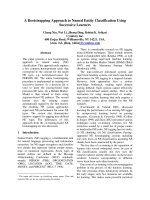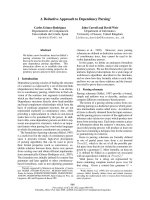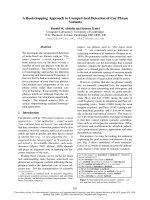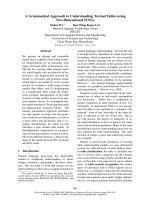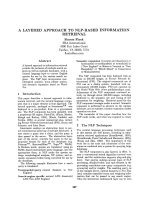Báo cáo khoa học: "A corpus-based approach to topic in Danish dialog∗" pptx
Bạn đang xem bản rút gọn của tài liệu. Xem và tải ngay bản đầy đủ của tài liệu tại đây (117.25 KB, 6 trang )
Proceedings of the ACL Student Research Workshop, pages 109–114,
Ann Arbor, Michigan, June 2005.
c
2005 Association for Computational Linguistics
A corpus-based approach to topic in Danish dialog
∗
Philip Diderichsen
Lund University Cognitive Science
Lund University
Sweden
philip.diderichsen lucs.lu.se
Jakob Elming
CMOL / Dept. of Computational Linguistics
Copenhagen Business School
Denmark
je.id cbs.dk
Abstract
We report on an investigation of the prag-
matic category of topic in Danish dia-
log and its correlation to surface features
of NPs. Using a corpus of 444 utter-
ances, we trained a decision tree system
on 16 features. The system achieved near-
human performance with success rates of
84–89% andF
1
-scores of0.63–0.72 in10-
fold cross validation tests (human perfor-
mance: 89% and 0.78). The most im-
portant features turned out to be prever-
bal position, definiteness, pronominalisa-
tion, and non-subordination. We discov-
ered that NPs in epistemic matrix clauses
(e.g. “I think ”) were seldom topics and
we suspect that this holds for other inter-
personal matrix clauses as well.
1 Introduction
The pragmatic category of topic is notoriously dif-
ficult to pin down, and it has been defined in many
ways (B
¨
uring, 1999; Davison, 1984; Engdahl and
Vallduv
´
ı, 1996; Gundel, 1988; Lambrecht, 1994;
Reinhart, 1982; Vallduv
´
ı, 1992). The common de-
nominator is the notion of topic as what an utter-
ance is about. We take this as our point of depar-
ture in this corpus-based investigation of the corre-
lations between linguistic surface features and prag-
matic topicality in Danish dialog.
∗
We thank Daniel Hardt and two anonymous reviewers for
many helpful comments on drafts of this paper.
Danish is a verb-second language. Its word order
is fixed, but only to a certain degree, in that it al-
lows any main clause constituent to occur in the pre-
verbal position. The first position thus has a privi-
leged status in Danish, often associated with topical-
ity (Harder and Poulsen, 2000; Togeby, 2003). We
were thus interested in investigating how well the
topic correlates with the preverbal position, along
with other features, if any.
Our findings could prove useful for the further in-
vestigation of local dialog coherence in Danish. In
particular, it may be worthwile in future work to
study the relation of our notion of topic to the C
b
of Grosz et al.s (1995) Centering Theory.
2 The corpus
The basis of our investigation was two dialogs from
a corpus of doctor-patient conversations (Hermann,
1997). Each of the selected dialogs was between a
woman in her thirties and her doctor. The doctor was
the same in the two conversations, and the overall
topic of both was the weight problems of the patient.
One of the dialogs consisted of 125 utterances (165
NPs), the other 319 (449 NPs).
3 Method
The investigation proceeded in three stages: first,
the topic expressions (see below) of all utterances
were identified
1
; second, all NPs were annotated for
linguistic surface features; and third, decision trees
1
Utterances with dicourse regulating purpose (e.g. yes/no-
answers), incomplete utterances, and utterances without an NP
were excluded.
109
were generated in order to reveal correlations be-
tween the topic expressions and the surface features.
3.1 Identification of topic expressions
Topics are distinguished from topic expressions fol-
lowing Lambrecht (1994). Topics are entities prag-
matically construed as being what an utterance is
about. A topic expression, on the other hand, is an
NP that formally expresses the topic in the utterance.
Topic expressions were identified through a two-step
procedure; 1) identifying topics and 2) determining
the topic expressions on the basis of the topics.
First, the topic was identified strictly based on
pragmatic aboutness using a modified version of the
‘about test’ (Lambrecht, 1994; Reinhart, 1982).
The about test consists of embedding the utter-
ance in question in an ‘about-sentence’ as in Lam-
brecht’s example shown below as (1):
(1) He said about the children that they went to school.
This is a paraphrase of the sentence the children
went to school which indicates that the referent of
the children is the topic because it is appropriate (in
the imagined discourse context) to embed this refer-
ent as an NP in the about matrix clause. (Again, the
referent of the children is the topic, while the NP the
children is the topic expression.)
We adapted the about test for dialog by adding a
request to ‘say something about ’ or ‘ask about
’ before the utterance in question. Each utter-
ance was judged in context, and the best topic was
identified as illustrated below. In example (2), the
last utterance, (2-D
3
), was assigned the topic TIME
OF LAST WEIGHING. This happened after consider-
ing which about construction gave the most coherent
and natural sounding result combined with the utter-
ance. Example (3) shows a few about constructions
that the coder might come up with, and in this con-
text (3-iv) was chosen as the best alternative.
(2) D
1
sid
sit
ned
down
og
and
lad
let
mig
me
høre,
hear,
Annette (made-up name)
Annette
P
1
jeg
I
skal
shall
bare
just
vejes
be.weighed
P
2
og
and
s
˚
a
then
skal
shall
jeg
I
have
have
svar
answer
fra
from
sidste
last
gang
time
D
2
s
˚
a
then
skal
let
vi
us
se
see
en
one
gang
time
D
3
det
it
er
is
fjorten
fourteen
dage
days
siden
since
du
you
blev
were
vejet
weighed
(3) i. Say something about THE PATIENT (=you).
ii. Say something about THE WEIGHING OF THE PA-
TIENT.
iii. Say something about THE LAST WEIGHING OF THE
PATIENT.
iv. Say something about THE TIME OF LAST WEIGHING
OF THE PATIENT.
Creating the about constructions involved a great
deal of creativity and made them difficult to com-
pare. Sometimes the coders chose the exact same
topic, at other times they were obviously differ-
ent, but frequently it was difficult to decide. For
instance, for one utterance Coder 1 chose OTHER
CAUSES OF EDEMA SYMPTOM, while Coder 2
chose THE EDEMA’S CONNECTION TO OTHER
THINGS. Slightly different wordings like these made
it impossible to test the intersubjectivity of the topic
coding.
The second step consisted in actually identifying
the topic expression. This was done by selecting the
NP in the utterance that was the best formal repre-
sentation of the topic, using 3 criteria:
1. The topic expression is the NP in the utterance that refers
to the topic.
2. If no such NP exists, then the topic expression is the NP
whose referent the topic is a property or aspect of.
3. If no NP fulfills one of these criteria, then the utterance
has no topic expression.
In the example from before, (2-D
3
), it was judged
that det ‘it’ (emphasized) was the topic expression
of the utterance, because it shared reference with the
chosen topic from (3-iv).
If two NPs in an utterance had the same reference,
the best topic representative was chosen. In reflexive
constructions like (4), the non-reflexive NP, in this
case jeg ‘I’, is considered the best representative.
(4) men
but
jeg
I
har
have
ikke
not
tabt
lost
mig
me (i.e. lost weight)
In syntactially complex utterances, the best repre-
sentative of the topic was considered the one occur-
ring in the clause most closely related to the topic. In
the following example, since the topic was THE PA-
TIENT’S HANDLING OF EATING, the topic expres-
sion had to be one of the two instances of jeg ‘I’.
Since the topic arguably concerns ‘handling’ more
than ‘eating’, the NP in the matrix clause (empha-
sized) is the topic expression.
110
(5) jeg
I
har
have
slet
really
ikke
not
tænkt
thought
p
˚
a
about
hvad
what
jeg
I
har
have
spist
eaten
A final example of several NPs referring to the
same topic has to do with left-dislocation. In ex-
ample (6), the preverbal object ham ‘him’ is imme-
diately preceded by its antecedent min far ‘my fa-
ther’. Both NPs express the topic of the utterance. In
Danish, resumptive pronouns in left-dislocation con-
structions always occur in preverbal position, and in
cases where they express the topic there will thus
always be two NPs directly adjacent to each other
which both refer to the topic. In such cases, we con-
sider the resumptive pronoun the topic expression,
partly because it may be considered a more inte-
grated part of the sentence (cf. Lambrecht (1994)).
(6) min
my
far
father
ham
him
s
˚
a
saw
jeg
I
sjældent
seldom
The intersubjectivity of the topic expression an-
notation was tested in two ways. First, all the topic
expression annotations of the two coders were com-
pared. This showed that topic expressions can be an-
notated reasonably reliably (κ = 0.70 (see table 1)).
Second, to make sure that this intersubjectivity was
not just a product of mutual influence between the
two authors, a third, independent coder annotated a
small, random sample of the data for topic expres-
sions (50 NPs). Comparing this to the annotation of
the two main coders confirmed reasonable reliability
(κ = 0.70).
3.2 Surface features
After annotating the topics and topic expressions, 16
grammatical, morphological, and prosodic features
were annotated. First the smaller corpus was anno-
tated by the two main coders in collaboration in or-
der to establish annotating policies in unclear cases.
Then the features were annotated individually by the
two coders in the larger corpus.
Grammatical roles. Each NP was categorized as
grammatical subject (sbj), object (obj), or oblique
(obl).These features can be annotated reliably (sbj: C1
(number of sbj’s identified by Coder 1) = 208, C2 (sbj’s identified by Coder 2) =
207, C1+2 (Coder 1 and 2 overlap) = 207, κ
sbj
= 1.00; obj: C1 = 110, C2 = 109,
C1+2 = 106, κ
obj
= 0.97; obl: C1 = 30, C2 = 50, C1+2 = 29, κ
obl
= 0.83).
Morphological and phonological features. NPs
were annotated for pronominalisation (pro), defi-
niteness (def), and main stress (str). (Note that the
main stress distinction only applies to pronouns in
Danish.) These can also be annotated reliably (pro:
C1 = 289, C2 = 289, C1+2 = 289, κ
pro
= 1.00; def: C1 = 319, C2 = 318, C1+2 =
318, κ
def
= 0.99; str: C1 = 226, C2 = 226, C1+2 = 203, κ
str
= 0.80).
Unmarked surface position. NPs were anno-
tated for occurrence in pre-verbal (pre) or post-
verbal (post) position relative to their subcategoriz-
ing verb. Thus, in the following example, det ‘it’ is
+pre, but –post, because det is not subcategorized
by tror ‘think’.
(7) Ø
(I)
tror
think
[
+pre,–post
[
+pre,–post
det]
it]
hjælper
helps
lidt
a little
In addition to this, NPs occurring in pre-verbal
position were annotated for whether they were rep-
etitions of a left-dislocated element (ldis). Example
(8) further exemplifies the three position-related fea-
tures.
(8) min
my
far
father
[
+ldis,+pre
ham]
[
+ldis,+pre
him]
s
˚
a
saw
[
+post
jeg]
[
+post
I]
sjældent
seldom
All three features can be annotated highly reliably
(pre: C1 = 142, C2 = 142, C1+2 = 142, κ
pre
= 1.00; post: C1 = 88, C2 = 88,
C1+2 = 88, κ
post
= 1.00; ldis: C1 = 2, C2 = 2, C1+2 = 2, κ
ldis
= 1.00).
Marked NP-fronting. This group contains NPs
fronted in marked constructions such as the pas-
sive (pas), clefts (cle), Danish ‘sentence intertwin-
ing’ (dsi), and XVS-constructions (xvs).
NPs fronted as subjects of passive utterances were
annotated as +pas.
(9) [
+pas
jeg]
[
+pas
I]
skal
shall
bare
just
vejes
be.weighed
A cleft construction is defined as a complex con-
struction consisting of a copula matrix clause with
a relative clause headed by the object of the matrix
clause. The object of the matrix clause is also an
argument or adjunct of the relative clause predicate.
The clefted element det ‘that’, which we annotate as
+cle, leaves an ‘empty slot’, e, in the relative clause,
as shown in example (10):
(10) det
it
er
is
jo
after all
ikke
not
[
+cle
det
i
]
[
+cle
that
i
]
du
you
skal
shall
tabe dig
lose weight
af
from
e
i
e
i
som
as
s
˚
adan
such
Danish sentence intertwining can be defined as
a special case of extraction where a non-WH con-
stituent of a subordinate clause occurs in the first
111
position of the matrix clause. As in cleft construc-
tions, an ‘empty slot’ is left behind in the subordi-
nate clause. NPs in the fronted position were anno-
tated as +dsi:
(11) [
+dsi
det
i
]
[
+dsi
that
i
]
tror
think
jeg
I
ikke
not
det
it
gør
does
e
i
e
i
The XVS construction is defined as a simple
declarative sentence with anything but the subject in
the preverbal position. Since only one constituent is
allowed preverbally
2
, the subject occurs after the fi-
nite verb. In example (12), the finite verb is an auxil-
iary, and the canonical position of the object after the
main verb is indicated with the ‘empty slot’ marker
e. The preverbal element in XVS-constructions is
annotated as +xvs.
(12) [
+xvs
det
i
]
[
+xvs
that
i
]
har
have
jeg
I
alts
˚
a
truly
haft
had
e
i
e
i
før
before
All four features can be annotated highly reliably
(pas: C1 = 1, C2 = 1, C1+2 = 1, κ
pas
= 1.00; cle: C1 = 4, C2 = 4, C1+2 = 4,
κ
cle
= 1.00; dsi C1 = 3, C2 = 3, C1+2 = 3, κ
dsi
= 1.00; xvs: C1 = 18, C2 = 18,
C1+2 = 18, κ
xvs
= 1.00).
Sentence type and subordination. Each NP was
annotated with respect to whether or not it appeared
in an interrogative sentence (int) or a subordinate
clause (sub), and finally, all NPs were coded as to
whether they occurred in an epistemic matrix clause
or in a clause subordinated to an epistemic matrix
clause (epi). An epistemic matrix clause is defined
as a matrix clause whose function it is to evaluate
the truth of its subordinate clause (such as “I think
”). The following example illustrates how we an-
notated both NPs in the epistemic matrix clause and
NPs in its immediate subordinate clause as +epi, but
not NPs in further subordinated clauses. The +epi
feature requires a +/–sub feature in order to deter-
mine whether the NP in question is in the epistemic
matrix clause or subordinated under it. Subordina-
tion is shown here using parentheses.
(13) [
+epi
[
+epi
jeg]
I]
tror
think
mere
rather
(
(
[
+epi,+sub
[
+epi,+sub
det]
it]
er
is
fordi
because
(at
(that
[
+sub
[
+sub
man]
you]
spiser
eat
p
˚
a
at
[
+sub
[
+sub
dumme
stupid
tidspunkter]
times]
ik’))
right))
All features in this group can be annotated reli-
2
Only one constituent is allowed in the intrasentential pre-
verbal position. Left-dislocated elements are not considered
part of the sentence proper, and thus do not count as preverbal
elements, cf. Lambrecht (1994).
ably (int: C1 = 55, C2 = 55, C1+2 = 55, κ
int
= 1.00; sub: C1 = 117, C2 =
111, C1+2 = 107, κ
sub
= 0.93; epi: C1 = 38, C2 = 45, C1+2 = 37, κ
epi
= 0.92).
3.3 Decision trees
In the third stage of our investigation, a decision tree
(DT) generator was used to extract correlations be-
tween topic expressions and surface features. Three
different data sets were used to train and test the
DTs, all based on the larger dialog.
Two of these data sets were derived from the com-
plete set of NPs annotated by each main coder in-
dividually. These two data sets will be referred to
below as the ‘Coder 1’ and ‘Coder 2’ data sets.
The third data set was obtained by including only
NPs annotated identically by both main coders in
relevant features
3
. This data set represents a higher
degree of intersubjectivity, especially in the topic ex-
pression category, but at the cost of a smaller number
of NPs. 63 out of a total of 449 NPs had to be ex-
cluded because of inter-coder disagreement, 50 due
to disagreement on the topic expression category.
This data set will be referred to below as the ‘In-
tersection’ data set.
A DT was generated for each of these three data
sets, and each DT was tested using 10-fold cross val-
idation, yielding the success rates reported below.
4 Results
Our results were on the one hand a subset of the
features examined that correlated with topic expres-
sions, and on the other the discovery of the impor-
tance of different types of subordination. These re-
sults are presented in turn.
4.1 Topic-indicating features
The optimal classification of topic expressions in-
cluded a subset of important features which ap-
peared in every DT, i.e. +pro, +def, +pre, and –sub.
Several other features occurred in some of the DTs,
i.e. dsi, int, and epi. The performance of all the DTs
is summarized in table 2 below.
3
“Relevant features” were determined in the following way:
A DT was generated using a data set consisting only of NPs
annotated identically by the two coders in all the features, i.e.
the 16 surface features as well as the topic expression feature.
The features constituting this DT, i.e. pro, def, sub, and pre, as
well as the topic expression category, were relevant features for
the third data set, which consisted only of NPs coded identically
by the two coders in these 5 features.
112
The DT for the Coder 1 data set contains the fea-
tures def, pro, dsi, sub, and pre. According to this
classification, a definite pronoun in the fronted po-
sition of a Danish sentence intertwining construc-
tion is a topic expression, and other than that, def-
inite pronouns in the preverbal position of non-
subordinate clauses are topic expressions. The 10-
fold cross validation test yields an 84% success rate.
F
1
-score: 0.63.
The Coder 2 DT contains the features pro, def,
sub, pre, int, and epi. Here, if a definite pronoun
occurs in a subordinate clause it is not a topic ex-
pression, and otherwise it is a topic expression if it
occurs in the preverbal position. If it does not oc-
cur in preverbal position, but in a question, it is also
a topic expression unless it occurs in an epistemic
matrix clause. Success rate: 85%. F
1
-score: 0.67.
Finally, the Intersection DT contains the features
pro, def, sub, and pre. According to this DT,
only definite pronouns in preverbal position in non-
subordinate clauses are topic expressions. The DT
has a high success rate of 89% in the cross vali-
dation test — which is not surprising, given that a
large number of possibly difficult cases have been
removed (mainly the 50 NPs where the two coders
disagreed on the annotation of topic expressions).
F
1
-score: 0.72.
Since there is no gold standard for annotating
topic expressions, the best evaluation of the human
performance is in terms of the amount of agreement
between thetwo coders. Success rate and F
1
analogs
for human performance were therefore computed as
follows, using the figures displayed in table 1.
Coder 2 Total
Topic Non-topic
Coder 1 Topic 88 27 115
Non-topic 23 311 334
Total 111 338 449
Table 1: The topic annotation of Coder 1 and Coder 2.
Success rate analog: The agreement percentage
between the human coders when annotating topic
expressions (
449 NPS−(23+27) NPS
449 NPS
×100 = 89%).
F
1
analog: The performance of Coder 1 eval-
uated against the performance of Coder 2 (“Preci-
sion”:
88
88+27
= 0.77; “Recall”:
88
88+23
= 0.79; “F
1
”:
2 ×
0.77×0.79
0.77+0.79
= 0.78).
Data set Coder 1 Coder 2 Intersect. Human
Total NPs 449 449 386 449
Success rate 84% 85% 89% 89%
Precision 0.77 0.74 0.79 0.79
Recall 0.53 0.61 0.67 0.77
F
1
-score 0.63 0.67 0.72 0.78
Table 2: Success rates, Precision, Recall, and F
1
-scores for
the three different data sets. For comparison, we added success
rate and F
1
analogs for human performance.
4.2 Interpersonal subordination
We found that syntactic subordination does not have
an invariant function as far as information structure
is concerned. The emphasized NPs in the following
examples are definite pronouns in preverbal position
in syntactically non-subordinate clauses. But none
of them are perceived as topic expressions.
(14) s
˚
a
so
det
it
kan
may
godt
well
være
be
at
that
hvis
if
man
you
har
have
tabt
lost
noget
some
mere
more
i løbet af
during
ugen
the.week
ik’
right
(15) jeg
I
tror
think
mere
rather
det
it
er
is
fordi
because
at
that
man
you
spiser
eat
p
˚
a
at
dumme
stupid
tidspunkter
times
ik’
right
The reason seems to be that these NPs occur in
epistemic matrix clauses (+epi).
The following utterances have not been annotated
for the +epi feature, since the matrix clauses do not
seem to state the speaker’s attitude towards the truth
of the subordinate clause. However, the emphasized
NPs seem to stand in a very similar relation to the
message being conveyed, and none of them were
perceived as topic expressions.
(16) men
but
alts
˚
a
you know
jeg
I
har
have
bare
just
bemærket
noticed
at
that
at
that
det
it
er
has
blevet
become
værre
worse
ik’
right
(17) og
and
det
that
kan
can
man
you
da
though
sige
say
p
˚
a
in
tre
three
uger
weeks
det
that
er
is
da
surely
ikke
not
vildt
wildly
meget
much
This suggests that a more general type of matrix
clause than the epistemic matrix clause, namely the
interpersonal matrix clause (Jensen, 2003) would be
relevant in this context. This category would cover
all of the above cases. It is defined as a matrix
clause that expresses some attitude towards the mes-
113
sage conveyed in its subordinate clause. This more
general category presumably signals non-topicality
rather than topicality just like the special case of
epistemic subordination.
5 Summary and future work
We have shown that it is possible to generate al-
gorithms for Danish dialog that are able to predict
the topic expressions of utterances with near-human
performance (success rates of 84–89%, F
1
scores of
0.63–0.72).
Furthermore, our investigation has shown that
the most characteristic features of topic expres-
sions are preverbal position (+pre), definiteness
(+def), pronominal realisation (+pro), and non-
subordination (–sub). This supports the traditional
view of topic as the constituent in preverbal position.
Most interesting is subordination in connection
with certain matrix clauses. We discovered that NPs
in epistemic matrix clauses were seldom topics. In
complex constructions like these the topic expres-
sion occurs in the subordinate clause, not the ma-
trix clause as would be expected. We suspect that
this can be extended to the more general category of
inter-personal matrix clauses.
Future work on dialog coherence in Danish, par-
ticularly pronoun resolution, may benefit from our
results. The centering model, originally formulated
by Grosz et al. (1995), models discourse coherence
in terms of a ‘local center of attention’, viz. the
backward-looking center, C
b
. Insofar as the C
b
cor-
responds to a notion like topic, the corpus-based in-
vestigation reported here might serve as the empiri-
cal basis for an adaptation for Danish dialog of the
centering model. Attempts have already been made
to adapt centering to dialog (Byron and Stent, 1998),
and, importantly, work has also been done on adapt-
ing the centering model to other, freer word order
languages such as German (Strube and Hahn, 1999).
References
Daniel B
¨
uring. 1999. Topic. In Peter Bosch and Rob
van der Sandt, editors, Focus — Linguistic, Cogni-
tive, and Computational Perspectives, pages 142–165.
Cambridge University Press.
Donna K. Byron and Amanda J. Stent. 1998. A prelim-
inary model of centering in dialog. Technical report,
The University of Rochester.
Alice Davison. 1984. Syntactic markedness and the def-
inition of sentence topic. Language, 60(4).
Elisabeth Engdahl and Enric Vallduv
´
ı. 1996. Informa-
tion packaging in HPSG. Edinburgh working papers
in cognitive science: Studies in HPSG, 12:1–31.
Barbara J. Grosz, Aravind K. Joshi, and Scott Weinstein.
1995. Centering: a framework for modeling the lo-
cal coherence of discourse. Computational linguistics,
21(2):203–225.
Jeanette K. Gundel. 1988. Universals of topic-comment
structure. In Michael Hammond, Edith Moravcsik,
and Jessica Wirth, editors, Studies in syntactic typol-
ogy, volume 17 of Studies in syntactic typology, pages
209–239. John Benjamins Publishing Company, Ams-
terdam/Philadelphia.
Peter Harder and Signe Poulsen. 2000. Editing for
speaking: first position, foregrounding and object
fronting in Danish and English. In Elisabeth Engberg-
Pedersen and Peter Harder, editors, Ikonicitet og struk-
tur, pages 1–22. Netværk for funktionel lingvistik,
Copenhagen.
Jesper Hermann. 1997. Dialogiske forst
˚
aelser og deres
grundlag. In Peter Widell and Mette Kunøe, editors,
6. møde om udforskningen af dansk sprog, pages 117–
129. MUDS,
˚
Arhus.
K. Anne Jensen. 2003. Clause Linkage in Spoken Dan-
ish. Ph.D. thesis from the University of Copenhagen,
Copenhagen.
Knud Lambrecht. 1994. Information structure and sen-
tence form: topic, focus and the mental representa-
tions of discourse referents. Cambridge University
Press, Cambridge.
Tanya Reinhart. 1982. Pragmatics and linguistics. an
analysis of sentence topics. Distributed by the Indiana
University Linguistics Club., pages 1–38.
Michael Strube and Udo Hahn. 1999. Functional center-
ing — grounding referential coherence in information
structure. Computational linguistics, 25(3):309–344.
Ole Togeby. 2003. Fungerer denne sætning? – Funk-
tionel dansk sproglære. Gads forlag, Copenhagen.
Enric Vallduv
´
ı. 1992. The informational component.
Ph.D. thesis from the University of Pennsylvania,
Philadelphia.
114
